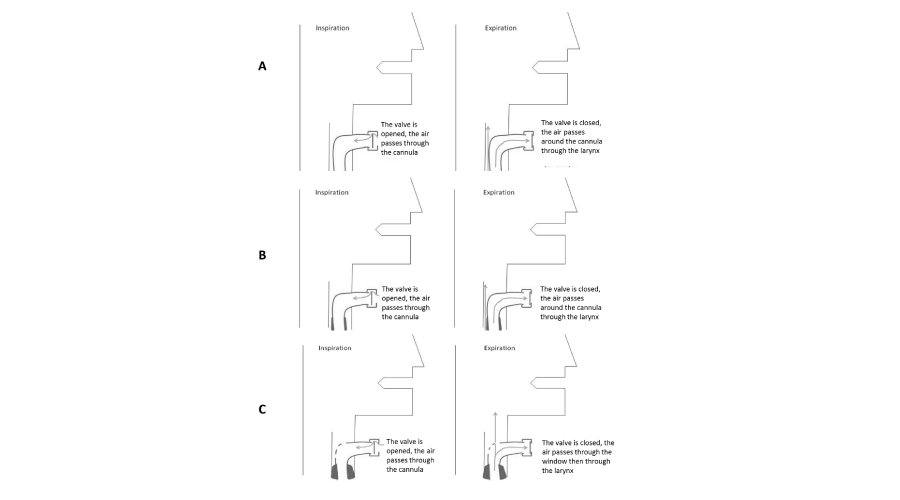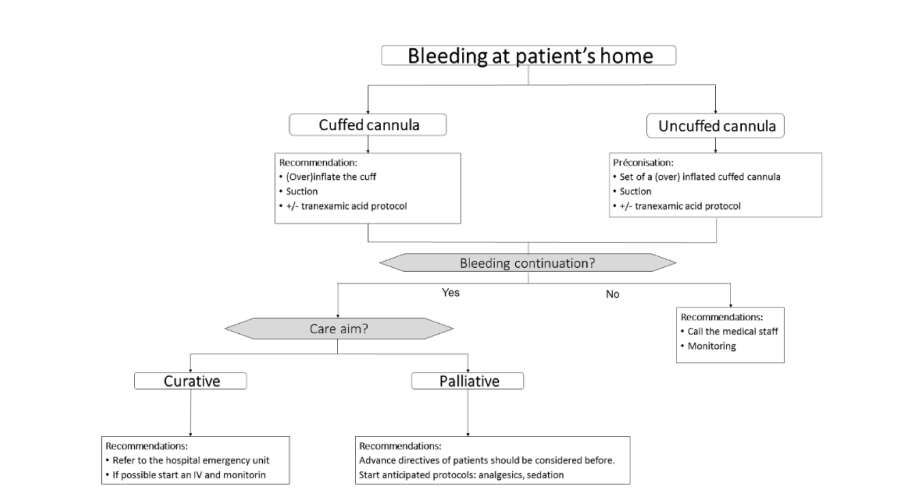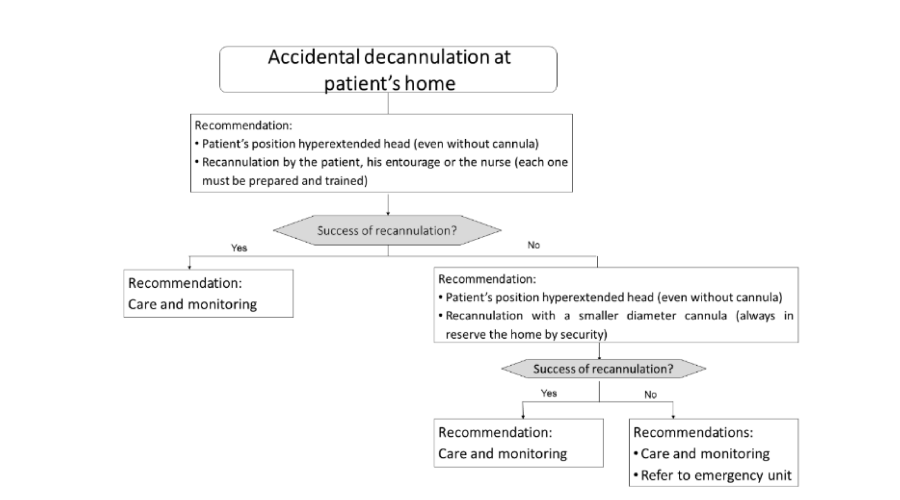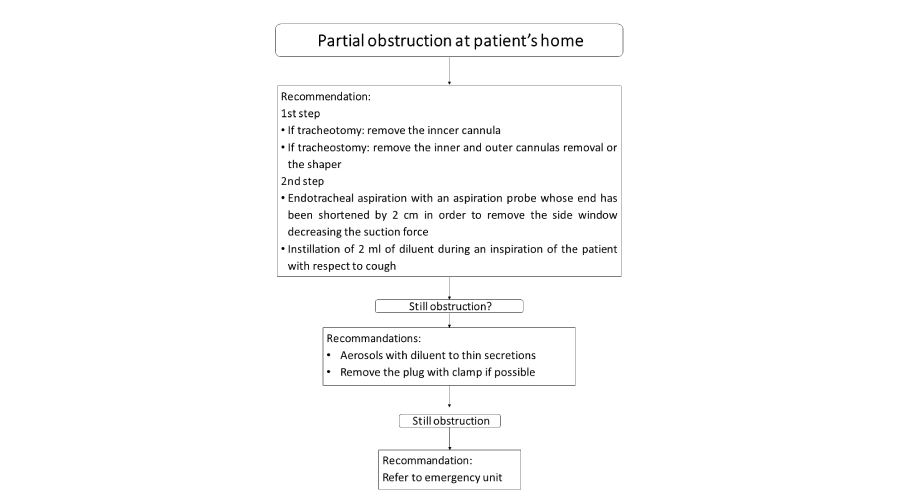Authors:
Guillaume Buiret1*, Laura Gautheron2 and Hélène Labrosse-Canat2
1ENT department and head and neck Surgery, Association Francophone des Soins Oncologiques de Support, Hospital of Valence, 179 Boulevard du Maréchal Juin, 26953 Valencia, France
2Regional Network of Cancer, Association Francophone des Soins Oncologiques de Support, Bio Park / Adenine, 60 Avenue Rockefeller, 69373 Lyon Cedex 08, France
Received: 01 November, 2016; Accepted: 08 November, 2016; Published: 09 November, 2016
Guillaume Buiret, ENT Department, Valencia Hospital, 195 Boulevard Marécal June, 26953 Valencia, France, Tel: +33475757575; Fax: +33475757110: E-mail:
Buiret G, Gautheron L, Labrosse-Canat H (2016) Tracheotomy/Tracheostomy Management at Home and in Care Centers. Arch Otolaryngol Rhinol 2(1): 061-069. DOI: 10.17352/2455-1759.000027
© 2016 Buiret G, et al. This is an open-access article distributed under the terms of the Creative Commons Attribution License, which permits unrestricted use, distribution, and reproduction in any medium, provided the original author and source are credited.
Tracheotomy; Tracheostomy; Care management; Supportive care
Aim and objectives: Formalize a consensus about patient’s care management (nursing techniques, management of complications) with tracheotomy or tracheostomy at home and in care center.
Background: Tracheotomy and tracheostomy are medical devices used for many years thus inspiring fear mainly by their symbolic impacts and the lack of training of health professionals.
Design: This study is a mixed research with a qualitative methodology including iterative focus groups.
Methods: A national call for project was performed on Internet to recruit multi-professional volunteers early 2015, anyone was accepted. Seven phone call with focus groups, each 2 hours, were set during 2015. Finally the project was presented and validated in “Guidelines and French Oncology Networks” J2R congress in Nantes, France in December 2015 and published on the web.
Results: Definitions, anatomic and physiologic notions, then the different types of cannulas are presented in the document. The management of tracheotomy/tracheostomy daily cares with protocols and videos, of the complications (infections, bleeding …), of functional sequelae (phonation, swallowing) at home and in care centers is then explained and demonstrated.
Conclusions: Finally, this work has led to a national consensus on the management, at home and in care centers, of tracheotomy and tracheostomy management and their potential complications.
Relevance to clinical practice: Such a work has never been done before. It aims to be comprehensive and didactic by means of figures and decision trees. This study will be useful and could be implemented despite local habits.
Introduction
Tracheotomy and tracheostomy are medical devices used for many years. This technique was first described during the second century AD by Galien and Aretaeus of Cappadocia [1]. Even though a tracheostomy is performed only in an oncological purpose, there are many reasons of performing a tracheotomy (oncological or neurological fields, after a prolonged intubation in Intensive Care Units…). However those devices are still inspiring fear which is mainly caused by their symbolic impacts (speech, swallowing, breathing, appearance) and the lack of training of healthcare professionals in use of such devices. After leaving their specialized center (surgery or rehabilitation center), patients and their caregivers are forced to fend for themselves or under care of inadequately trained medical and paramedical professionals. This means a lot of distress on the patient’s side but also on the health professional’s side and a frequent refusal of care.
Very little objective data concerning the care management of patients suffering from local habits are reported in the specialized literature.
AIM
The aim of this national working group was to formalize a consensus on care management (nursing techniques, management of complications) of patients with tracheotomy or tracheostomy at patients’ home and in care centers, whatever the cause of tracheotomy / tracheostomy is, benign or malignant.
Methods
Design
This study is a mixed research [2] combining both quantitative and qualitative researches. Furthermore, the methodology of a qualitative research with iterative focus groups was applied and the Consolidated Criteria for Reporting Qualitative Research (COREQ) checklist is reported in Table 1.
Setting / Participants
The group was supported by the French Association for Supportive Care in Oncology (AFSOS) and the Regional Oncology Network of Rhone Alps, Lyon, France. A national call for project was performed on Internet to recruit multi-professional volunteers at the beginning of 2015, anyone was accepted.
The multi-professional group includes two nurses in primary care centers, six nurses in tertiary centers, one ENT surgeon in secondary center, two ENT surgeons in tertiary centers, one oncologist in tertiary center, one General Practitioner in primary center, one resuscitator in tertiary center, one pharmacist, and one dietician.
Seven phone call with focus groups, each 2 hours, were set during 2015. Minutes performed during each meeting to modify the text which has been send by email to each participant before the next meeting.
Approval by every member of the focus group, another national call for the project was performed to recruit new readers to improve its quality. Then interregional guidelines have been reworked by new experts, submitted and approved during the “Guidelines and French Oncology Networks” congress in Nantes, France in December 2015. Finally they were published on AFSOS and regional oncology networks websites.
Results
Theoretical considerations
Definitions, anatomic and physiologic notions: They are presented in Table 2.
-

Table 2:
Definitions, anatomic and physiologic notions.
Different types of cannulas: Many types of cannulas exist. Eight different types can be described according to three options: with vs without (disposable or reusable) inner cannula (IC), cuffed vs cuffless and fenestrated vs non-fenestrated. For instance a cuffed fenestrated with an IC can be found, as well as a cuffless non-fenestrated without IC.
- Cannulas with and without IC
IC allows easy cleaning of sputum without removing the outer cannula (OC). It is therefore recommended to use IC for daily use.
Cannula without IC are common in intensive care units for sedated patients and when the caregivers are aware of the suction process and cleaning cares.
Shapers, with a wide collar and without IC, are used after total (pharyngo) laryngectomy to avoid tracheostomy stenosis.
- Cuffed and cuffless cannulas
A cuff protects the lungs from fluid leakage. Therefore it is recommended if there is a risk of bleeding (just after the operation for instance), of swallowing disorder (after head and neck surgery or neurological diseases) or of major gastroesophageal reflux.
The cuff can be inflated temporarily in risk situations (swallowing for example) and deflated the rest of the day. When the cuff is inflated and unless the cannula is fenestrated a valve must not be absolutely used (risk of asphyxia).
The gold-standard method of cuff-inflation is a manometer control: the cuff must be 20 to 25-cmH2O air-inflated. Under than 20cmH2O, cuff is not sealed; over than 25cmH2O, i.e. more than capillary pressure, mucosal necrosis then stenosis are possible. When there is no manometer available (especially at the patient’s home), the necessary air volume of air is a necessary parameter which must be transmitted from the health institution nurse to the home nurse. Alternatively the cuff can be air-inflated while the patient is speaking. When the patient is not able to speak, the cuff is filled-in enough. Very anecdotally (hyperbaric chamber) the cuff can be inflated with sterile water (volume determined by the ENT surgeon). A special attention must be paid in case of accidental cuff rupture due to the risk of aspiration.
Cuffless cannulas are more lightweight, allow speaking and must preferably be used when there is no risk of aspiration.
- Fenestrated and non-fenestrated cannulas
A fenestrated cannula has a window top-directed, facilitating the path of the airflow through the larynx (Figure 1C). The main convenient cannula for that purpose is a cuffed fenestrated with IC system with patient who swallows the wrong way. Two IC are provided: a fenestrated one and a non-fenestrated one. When the patient wants to speak, even if the cuff is filled-in, the fenestrated IC must be used. When the patient wants to eat, the non-fenestrated IC avoids aspiration.
-

Figure 1:
phonation with a valve. A: cuffless canula. B: non-fenestrated cuffed outer cannula with deflated cuff. C: fenestrated cuffed outer cannula with inflated cuff and fenestrated inner cannula.
- Optional and peripheral systems:
Fixation system: elastic, adjustable, comfortable but it present a risk of skin irritation, usually with Velcro® system. The fixation can also be facilitated by hooks. One man’s finger or two woman’s fingers should be put between the necklace and the neck. If this space is larger, the cannula may go out; if smaller it becomes too tight and uncomfortable.
Chuck: systematically provided for cuffed and some cuffless cannulas, this device is used instead of the IC into the OC. It protrudes slightly and ends with a sphere. It enables the cannula set being very little traumatic and decreasing the risk of swallowing the wrong way outer of the trachea.
Cone: fixed on the OC, it prevents the IC to move. The inner diameter is identical to the IC one, which allows to breathe easily.
Half-moon device: fixed on the OC, it also prevents the IC to move. A deflector twice-reduces the diameter of inspired airflow but allows deflection of sputum.
Speaking valve: includes a membrane which is opened when the patient is breathing in and closes when the patient is breathing out. It allows speaking and the beginning of cannula weaning.
Filter: connected to the outer extremity of the cannula, it avoids dusts, humidifies and warms the inspired air. Optionally, it includes a metal or silicon structure which uses expired water vapor to humidify and warm the inspired air. If they do not prevent bacteria colonization, they do not increase its frequency or type [3].
Practical considerations
Tracheotomy/tracheostomy daily care management:
• Cautions
Enteral feeding must be stopped two hours before the care and can begin just after.
Individual protective equipment is mandatory.
Information, reassurance of the patient and his closest entourage is strongly advised.
• Delays
In case of tracheotomy, from the operation to day +1 or 2, only the IC can be removed to be cleaned up, e.g. when skin is fixed around the tube. The necklace can also be prudently replaced if needed. At day + 2 or 3, the cuffed cannula can be replaced by a non-cuffed cannula (the presence of an ENT surgeon should be compulsory). A special training is then given to the patient and his entourage in order to become autonomous.
In case of tracheostomy, from the operation, the whole cannula can be removed to be cleaned up. The presence of an ENT surgeon is not mandatory but recommended. A special training is given to the patient and his entourage for autonomy as soon as possible.
Free videos are available for cuffed to cuffless cannula removal.
(http://espacecancer.sante-ra.fr/Ressources/referentiels/videos/Changement%20de%20canule%20(2015)_720p.mp4) and cannula removal by an autonomous patient
(http://espacecancer.sante-ra.fr/Ressources/referentiels/videos/Nettoyage%20larytube%20(2015)_720p.mp4).
• Cares
Local tracheotomy/tracheostomy care protocols must be done, describing every different cares. Habits are different from one country to another so a single protocol cannot be presented. Two French protocols are available for tracheotomy (http://espacecancer.sante-ra.fr/Ressources/Documents/Protocoles-soins/protocole_soins_tracheotomie_VF.pdf) and tracheostomy (http://espacecancer.sante-ra.fr/Ressources/Documents/Protocoles-soins/protocole_soins_tracheostomie_VF.pdf).
Infectious complications management: There is a continuum between colonization, tracheobronchitis and pneumonia and it is sometimes difficult to distinguish them.
The American Thorax Society [4], defines the as follows:
Colonization: isolation of a potential pathogen in tracheal microbiological cultures without purulent secretions or obvious clinical infection
Tracheobronchitis: clinical signs (fever greater than 38°C, purulent sputum) and biological signs (leukocytosis or leukopenia, positive culture of tracheal aspirates or sputum) without new or progressive radiographic infiltrate
Pneumonia: clinical and biological signs of tracheobronchitis and new or progressive radiographic infiltrate
• Types of microbiological cultures
The main problem here is the high rate of false positive because of tracheal colonization or contamination of the sample. Therefore bacteriological sampling techniques must be standardized [5,6]. For instance, endotracheal aspirate cultures give more micro-organisms than bronchoscopic ones.
Recommendations:
- The best sampling is bronchoscopic: bronchoalveolar lavage or protected specimen brush.
- Endotracheal aspiration is quite reliable when bronchoscopy is not available.
- Pericannular sampling must not be performed.
- Quantitative cultures are compulsory. Semi-quantitative cultures are not reliable for diagnosis and qualitative cultures overdiagnose infections.
Positive thresholds of quantitative cultures are reported in Table 3.
-

Table 3:
Positive thresholds of quantitative cultures. BAL = bronchoalveolar lavage, PSB = protected specimen brush, CFU = Colony-forming unit.
• Tracheal colonization
Colonization is precocious (less than two weeks [7], even from the first day [8]), polymicrobic (aerobic, anaerobic [7,9,10] and fungal [8], in 80 to 100% of cases) [7,11,12].
The mechanisms of colonization are very close to those of chronic obstructive pulmonary disease or bronchial dilation [13]:
- Loss of natural protection by oral and nasal fence allowing direct contamination of microorganisms in the trachea and bronchi. There are very few correlations in microorganisms between the upper aerodigestive tract and the tracheobronchial tract [14-16].
- Decrease of mucociliary clearance causing the stagnation of sputum.
Most of reported bacteriology studies [7-12] are now outdated and microbial ecology has probably been improved since. Most frequent aerobic bacteria were Pseudomonas aeruginosa (in up to 75% of patients), Haemophilus influenzae, Klebsiella pneumoniae, Staphylococcus aureus, Serratia marcescens, Proteus sp, alpha-hemolysis Streptococcus group, Acinetobacter baumanii. Most frequent anaerobic bacteria were Fusobacterium nucleatum, Peptostreptococcus sp, and Bacteroides fragilis. Most frequent fungi were Candida (54.5%, half of which are C. albicans), Aspergillus fumigatus and Aspergillus flavus.
• Recommendations:
A systematic bacteriological survey is strongly discouraged [9] because there is little agreement between the germs of colonization and those responsible for infections, or if it is the same seed, the antimicrobial susceptibility is often different, flora being unstable over long periods [13].
There is no interest in trying to eradicate the colonizing flora [4]. Indeed, after antibiotic treatment, microbiological samples are not sterilized with either the persistence of the same microorganisms or the appearance of new resistant germs [7,11,17].
• Tracheobronchitis and pneumonia
On average, the incidence of infectious episodes at home during one year (tracheobronchitis and pneumonia) was estimated at 10 per 100 person per year (83% of tracheobronchitis and 17% of pneumonia) [10].
There is no indication of probabilistic tracheobronchitis treatment because it is not an emergency. After bacteriological sampling, culture results must be awaited to prescribe a specific antibiotic therapy. Tracheobronchitis may improve spontaneously within 48 hours.
Pneumonia should be routinely treated with empiric antibiotic therapy according to environmental microbial ecology (intensive care unit vs general care unit vs home) secondarily adapted to the results of bacteriological samples.
Other complications management: They are summarized in Table 4.
-

Table 4:
Other complications management.
Functional sequelae management: Phonation with a cannula
• Phonation with a cuffless cannula
Without dyspnea or breathing intolerance, a phonation valve can be adapted to the cannula (Figure 1A).
• Phonation with a cuffed cannula
Phonation is possible only in two limited circumstances:
- The cuff is deflated (Figure 1B):
Phonation is possible but more difficult than when the cannula is cuffless because the presence of the balloon, even deflated, reduces the free area between the cannula and the tracheal wall so the outgoing air flow.
- The cuff is inflated but the IC and OC are fenestrated (Figure 1C)
Apart from these two circumstances, a speaking valve must never be put on a cuffed cannula.
In order to avoid errors, most centers do not use phonation valve for cuffed cannulas.
Swallowing with a cannula: Swallowing troubles may be associated with the presence of the cannula because it prevents the rise of the larynx complicating swallowing. Some centers advise against swallowing with the presence of the cannula and prefer to wait for the cannula removal before swallowing. On the other hand, a swallow in the wrong way is obvious (externalization through the cannula) and the patient can be suctioned immediately.
Swallowing troubles can also be independent from the presence of the cannula. The causes are various and often linked to the indication of tracheotomy:
- Pharyngolaryngeal hyposensitivity abolishing swallowing reflexes (prolonged intubation)
- Swallowing desynchronization
- Laryngeal disclosure
- Pharyngeal propulsion default (sequelae of surgery or radiotherapy)
- Delay in the opening of the upper esophageal sphincter
An ENT examination including a neurological examination and a fiberoptic laryngoscopy (with food testing and subglottic fiberoptic control by the tracheotomy hole) is a valuable aid for speech therapy which is the base of rehabilitation (relearning swallowing praxis, postures, food textures...).
- Monitoring of patients with tracheotomy / tracheostomy: Respiratory function:
- Respiratory amplitude, heart rate, agitation, sweating, pulling signs, SpO2, free airway
- Cuff pressure, better with a manometer. The cuff sealing must be daily verified: the inspired volume in the cuff must be equal to that which was injected. Otherwise, the balloon is surely become porous and the cannula is to change.
- Nature of tracheal aspirations: quantity and appearance of secretions (search for possible infection)
Fixing the cannula and tolerance of this fixation.
Home coming: Home coming must be anticipated in order to identify the patient needs and to arrange education of the patient and his entourage.
Multi-daily cannula cares must be organized with suctions, changes and/or cleaning of the cannula, aerosols… Material Management must be delivered and tested before the patient is returning home:
• Two tracheal vacuum suctioning systems including one with battery
• Equipment maintenance, cleaning, storage and verification
• One emergency cannula and one with smaller diameter in reserve
• Other equipment if needed (oxygen, aerosol, respirator)
Pharmacists or home health providers are essential to care.
Procedures to follow in case of problems must absolutely be known by the patient, his entourage and his caregivers: bleeding (Figure 2), accidental decannulation (Figure 3), and cannula obstruction (Figure 4).
-

Figure 2:
Procedures to follow in case of bleeding.
-

Figure 3:
Procedures to follow in case of accidental decannulation.
-

Figure 4:
Procedures to follow in case of cannula obstruction.
Discussion
The routine management of patients with tracheotomy or tracheostomy is problematic because of the lack of training of the patient, his entourage and the caregivers. The different devices provided with a cannula and their functions are sometimes not even known by the caregivers. After a reminder of the technical considerations, the different materials available and their indications, the article exposes a progressively obtained multi-professional and pragmatic consensus about care management of patients with tracheotomy or tracheostomy.
The design of the study was first discussed:
- A review of literature was an incomplete method because very little or no reference is available.
- A conventional quantitative research was not indicated. Indeed there was no data and the study design wasn’t subject to statistical assumptions and conditions.
- The aim of a qualitative study is to understand and interpret social interactions. The main purpose is the study of human and cultural impacts on a particular subject. However the data format of a qualitative study with iterative focus groups and field notes was interesting.
- A mixed research appeared to be particularly adapted. From an epistemological point of view, the purpose of our work corresponds to a pragmatic justification (what works for whom in specific contexts) [2]. Another interest was the flexibility in the study design: participant responses affected how and which questions researchers asked afterwards. A mixed research also allows connection between theory and practice.
As consequent we decided to use a mixed research for the purpose of the study using rigorously the methodology of a qualitative research (reported in Table 1). The national validation of the consensus followed two additional steps after the focus groups:
- A national diffusion for proofreading, the collection of data and consideration of remarks
- The reviewing with a group of experts during the “Guidelines and French Oncology Networks” congress.
The principal limitation of the present study is that very few references are available in the literature. Another limitation is the date of the publication especially bacteriological ones. By cons care have not changed since the routine use of tracheotomy.
Conclusion
After a schematic presentation of medical devices (types, functions, criteria of choices…), this work has led to a national consensus concerning the management at home and in care centers, of tracheotomy and tracheostomy and their potential complications.
Relevance for Clinical Practice
Such a work has never been done before. It aims to be, comprehensive and didactic with its figures and decision trees. This study will be useful to decline in each country in accordance to local habits.
Acknowledgements
The authors specially acknoledge Hubert Riccardi from the Réseau Régional de Cancérologie Rhône Alpes and Céline Labrosse for the English translation and all the contributors of the focus group of the Association Francophone des Soins Oncologiques de Support.
-
-
- Grillo HC (2013) Development of tracheal surgery: a historical review. Part 1: techniques of tracheal surgery. Ann Thoracic Surg 75: 610–619.
- Johnson B, Christensen L (2013) Quantitative, qualitative and mixed research. In Educational research: Quantitative, qualitative and mixed approaches. Thousand Oaks, CA, Sage Publications 29-56.
- Kramp B, Donat M, Dommerich S, Pau HW, Podbielski A (2009) Prospective controlled study of microbial colonization of the trachea in tracheotomized and laryngectomized patients with HME (heat and moisture exchanger). Acta Otolaryngologica 129: 1136-1144.
- American Thorax Society (2005) Guidelines for the management of adults with hospital-acquired, ventilator-associated, and healthcare-associated pneumonia. Am J Respir Crit Care Med 171: 388-416.
- Afolabi-Brown O, Marcus M, Speciale P, Pagala M, Kazachkov M (2014) Bronchoscopic and nonbronchoscopic methods of airway culturing in tracheostomized children. Respiratory Care 59: 582-587.
- Baughman RP, Thorpe JE, Staneck J, Rashkin M, Frame PT (1987) Use of the protected specimen brush in patients with endotracheal or tracheostomy tubes. Chest 91: 233-236.
- Brook I (1979) Bacterial colonization, tracheobronchitis, and pneumonia following tracheostomy and long-term intubation in pediatric patients. Chest 76: 420-424.
- Gniadek A, Krzysciak P, Hawryszuk A, Macura AB, Brzostek T, et al. (2013) Mycobiota of the air in hospital rooms and the fungal colonisation of tracheostomy tubes used by patients diagnosed with larynx cancer--preliminary research. Ann Parasitol 59: 67-71.
- Cline JM, Woods CR, Ervin SE, Rubin BK, Kirse DJ (2012) Surveillance tracheal aspirate cultures do not reliably predict bacteria cultured at the time of an acute respiratory infection in children with tracheostomy tubes. Chest 141: 625-631.
- Harlid R, Andersson G, Frostell CG, Jorbeck HJ, Ortqvist AB (1996) Respiratory tract colonization and infection in patients with chronic tracheostomy. A one-year study in patients living at home. Am J Respir Crit Care Med 154: 124-129.
- Morar P, Singh V, Jones AS, Hughes J, van Saene R (1998) Impact of tracheotomy on colonization and infection of lower airways in children requiring long-term ventilation: a prospective observational cohort study. Chest 113: 77-85.
- Gotsman MS, Whitby JL (1964) Respiratory Infection Following Tracheostomy. Thorax 19: 89-96.
- Cabello H, Torres A, Celis R, El-Ebiary M, Puig de la Bellacasa J, et al. (1997) Bacterial colonization of distal airways in healthy subjects and chronic lung disease: a bronchoscopic study. Eur Respir J 10: 1137-1144.
- Niederman MS, Ferranti RD, Zeigler A, Merrill WW, Reynolds HY (1984) Respiratory infection complicating long-term tracheostomy. The implication of persistent gram-negative tracheobronchial colonization. Chest 85 39-44.
- Adler A, Ben-David D, Schwaber MJ, Masarwa S, Schwartz D, et al. (2012) Prevalence of Streptococcus pneumoniae in respiratory samples from patients with tracheostomy in a long-term-care facility. J Clin Microbiol 50: 3368-3370.
- Bartlett JG, Faling LJ, Willey S (1978) Quantitative tracheal bacteriologic and cytologic studies in patients with long-term tracheostomies. Chest 74: 635-639.
- Pignatti P, Balestrino A, Herr C, Bals R, Moretto D, et al. (2009) Tracheostomy and related host-pathogen interaction are associated with airway inflammation as characterized by tracheal aspirate analysis. Respiratory Medicine 103: 201-208.
-









Table 1:
COREQ checklist.